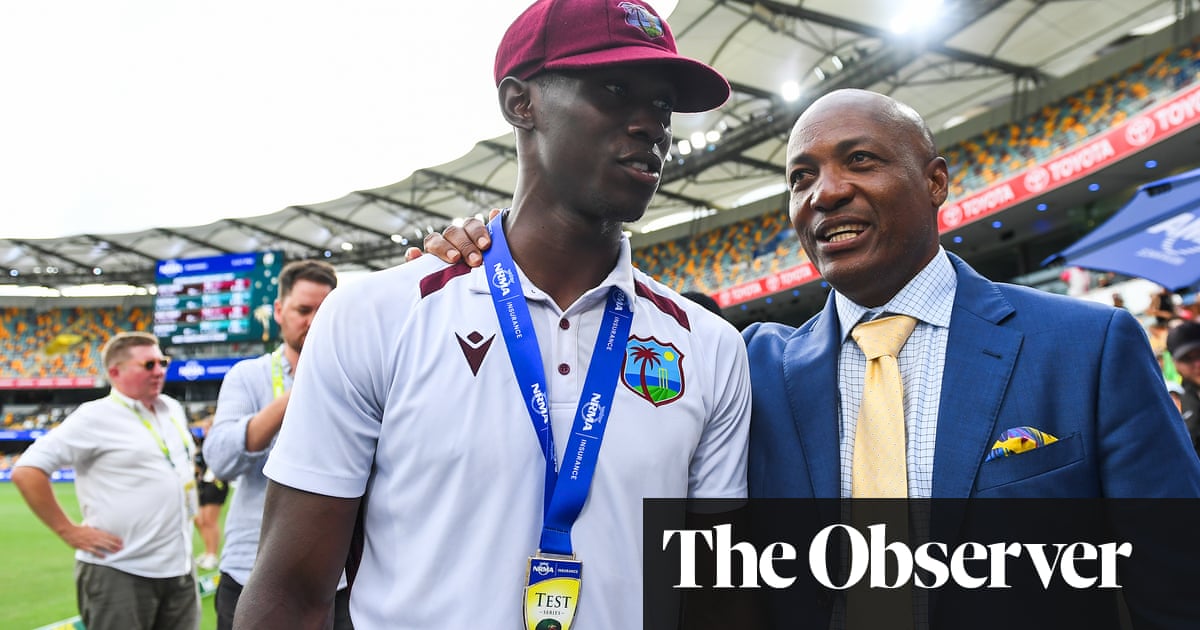
Cricketing legend is proud of the young team primed to take on England at Lord’s: ‘Hopefully their style will come out’
Taha Hashim
Sun 7 Jul 2024 08.00 BST
Share
Joy fills his voice but not the pure, childish type. It sounds like rediscovered happiness, amplified by the stinging pain of the past. “Young, inexperienced, written off,” bellows Brian Lara in the commentary box as Shamar Joseph, the irrepressible fast bowler with a battered toe, celebrates with his teammates.
“This West Indies team can stand tall today, West Indies cricket can stand tall today.” They have their first Test win in Australia since 1997.
Jimmy Anderson still has magic 21 years after England pin-up’s Test debut
Vic Marks
Read more
Lara’s lines were among the most stirring from the Gabba in January, the great left-hander visibly moved by the surprise triumph. “When you’re in Australia, you understand there’s going to be that slight arrogance [from Australia],” he says. “The final day, they felt it was going to be an easy task. I was just very proud of these young cricketers. Twenty-seven years it took us to win a Test match in Australia. I couldn’t be a happier West Indian.”
History matters to Lara, has since he was a boy in Trinidad, picking up books to go with the bat, reading about regional icons: George Headley and Learie Constantine, the three Ws – Weekes, Walcott and Worrell – and Garfield Sobers. It wasn’t just about cricket either. Lara, born seven years after Trinidad and Tobago gained independence, was well informed on matters of British rule.
“You have a lot more history taught to you about England, not just on the field but off the field. When you encounter something like that, and you’ve seen the past battles, you get a fair idea of the importance of walking out there in your West Indies colours to play against England. It becomes a little more than a cricket game.”
Brian Lara’s West Indies teammates form a guard of honour after his 375 against England at Antigua in 1994.
‘Impossible to bowl to’: Brian Lara’s record feats still stand out 30 years on
Read more
Lara’s knocks against the English made his legend, forming the focus of his new autobiography, Lara: The England Chronicles. In April 1994, he broke Sobers’s record for the highest Test score with a life-changing 375 against Michael Atherton’s team in Antigua. An unbeaten 501 for Warwickshire against Durham, a first-class record, followed a few weeks later. In April 2004, he punished Michael Vaughan’s side in St John’s with 400 not out.
The 375 meant more. “It was more hair-raising, it was more emotional,” he says. “You’ve got to appreciate the fact that I’m 24 years old. I’m trying to establish myself.” Lara began the day unbeaten on 320, the night just gone a sleepless one, his restlessness forcing him to play a round of golf before breakfast. A pull through midwicket took him past Sobers’s 365, prompting a fanatical pitch invasion.
A salute for Brian Lara after his record 375 against England in Antigua in April 1994.
View image in fullscreen
A salute for Brian Lara after his record 375 against England in Antigua in April 1994. Photograph: Ben Radford/Getty Images
“Men lying on the turf, crying, shouting,” Lara recalls in his book. “Hundreds of them, all trying to get a touch. Everywhere is uproar.”
Matthew Hayden amassed 380 for Australia against Zimbabwe in October 2003 to surpass Lara. Six months was all it took for him to return to the top but reclaiming the record was not what drove Lara there. With England 3-0 up in the series, his team needed to avoid embarrassment in the fourth Test.
“I had 100 runs in six innings, we’d lost three Test matches. I was appointed captain for the second time in 2003 and that was my focus, to try to be a better captain than I was previously. My mind was not on that [record].” But to have broken it again at the same ground against the same opposition? “I completely believe it’s destiny.”
The book, in tracing Lara’s international career from the early 90s to the mid-2000s, is most revealing on the formative years, overlapping with Viv Richards’s farewell. Lara was in effect his captain’s chauffeur on the 1991 tour of England, ferrying a dozing Richards from one ground to the next in a Vauxhall Calibra. It was a hard education, of bollockings and icy stares. But it was Viv. “Even though he brought that fear, the next day he would find me right underneath his arm again because I knew how important it was to be close to someone like that, to learn from someone like that.”
Nicholas Pooran strikes out for West Indies at the T20 World Cup.
View image in fullscreen
‘Everyone would love to see Nicholas Pooran in a Test match,’ says Lara. Photograph: Matthew Lewis/ICC/Getty Images
Lara would inherit Richards’s mantle as the team’s central figure but individual brilliance did not bring collective success. By 2004, England, brushed aside in previous decades, were the dominant team, beating West Indies in seven out of eight Tests that year. The pace and menace of Andrew Flintoff and Steve Harmison reminded Lara of what his side had lost.
“We took our eyes off the ball,” he says. “We had the best team in the world for 15, maybe 20 years. The rest of the world was learning from us. They understood the importance of fitness because we were the fittest team playing cricket in the 70s and 80s. They applied technology, tactical moves, formed academies to get their players up to standard.
“We continued on the way that natural ability is enough: the next Viv Richards is going to come around the corner, the next Curtly Ambrose is going to come around the corner. That’s not the case in today’s cricket. I still believe we have some of the best talents in the world but talent isn’t everything.”
West Indies’ Kavem Hodge cuts off the back foot against the First Class County Select XI at Beckenham
‘It brings West Indians together’: London locals enliven Test warm-up
Read more
Lara sees “outstanding young fast bowlers” in Joseph, Alzarri Joseph and Jayden Seales but worries about the inexperience of the batting before three Tests in England this month. He’d pick a more aggressive side.
“Everyone would love to see Nicholas Pooran in a Test match. I don’t know if he was asked, I don’t know the situation. I’d love to see a Shai Hope back in the West Indies team. But we’ve got to play with what we have. And what we have is a group of young players that want to play for West Indies, that want to play Test cricket. Hopefully their style will come out and they can be successful.”
His own success is something Lara ponders. “I was meant to keep the West Indies on top of the world and I couldn’t do it,” he writes in his autobiography. “I failed at my main purpose.”
Not everything is written off, though. “In my book I also ask if I entertained,” he says. “If I couldn’t keep the West Indies at the top of the tree at least I was playing a sport with people coming through the turnstiles to see me play. I want to know, did I at least satisfy that side of it?”
The answer is obvious.
Lara: The England Chronicles by Brian Lara (Trinorth, £25). To support the Guardian and Observer, order your copy at guardianbookshop.com. Delivery charges may apply.












